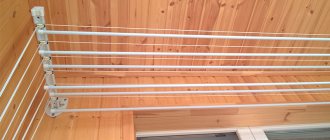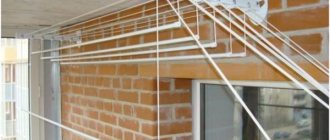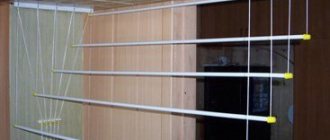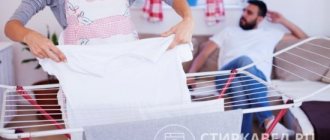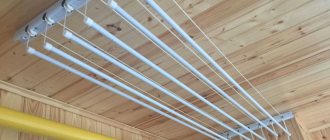Icer
34587 0 6
Icer September 12, 2016Specialization: master in the construction of plasterboard structures, finishing work and laying floor coverings. Installation of door and window units, finishing of facades, installation of electrical, plumbing and heating - I can give detailed advice on all types of work.
If washing machines take on all the worries about washing in modern conditions, then organizing the process of drying clothes still falls on the owners of the house, and if you have a balcony, then this is where you can install a special structure for these purposes. I will tell you about several options, consider all their pros and cons, so that you can make an informed choice. We will also consider options for homemade designs for those who like to make things with their own hands.
In the photo: modern manufacturers offer a lot of interesting and practical options for any balcony
Ceiling structure
A ceiling dryer on the balcony is an ergonomic solution. This model must be assembled after drying, which will free up more space on the balcony and not interfere with cleaning.
At the same time, it can hold more things and accommodate a full set of double bed linen.
Dryers that are built into the ceiling can be divided into the following types:
- Built-in : the structure is firmly attached to the ceiling surface.
- Removable : after drying the washed items, you can remove the metal divisions, leaving only the fasteners on the ceiling. Ideal for a balcony with a low ceiling.
- Two-tier : the upper compartment is built into the ceiling, the lower compartment can be installed as needed.
This model is reliable, thanks to metal elements in the form of long pipes, which are subsequently mounted in holders.
The assembly is adjusted using a strong cord that pushes the accordion mount to the required distance. In this case, you can dry up to 25 kg of various items.
For each model you can purchase metal hangers for drying outerwear. They are easily attached to individual elements.
Wall model
The most popular in use due to its ease of installation and use.
Options:
- With separate built-in fasteners in the form of hooks and subsequent installation of strong cables for drying clothes.
- The string model is distinguished by the presence of a “drum” for pulling ropes to the required area and number of things.
- The prefabricated structure in the form of an “accordion” is fully adjustable, which makes it possible to use it for a small amount of washed laundry, or when there is no space between the wall and the window.
The elements of the latest model are made of wood, aluminum, plastic, and steel. The design itself does not take up much space on the balcony, as does the folding wall-mounted balcony dryer with adjustment.
Its only drawback is the fragile ropes. Therefore, it cannot be used to dry outerwear or large amounts of laundry.
A wall-mounted clothes dryer for a balcony in the form of metal fastening hooks is quite easy to install. But, it should be noted that due to the abundance of laundry, the humidity on the balcony may increase, and things will dry unevenly.
Outdoor dryer
A common option among typical Soviet-built apartment buildings.
Due to the fact that in those days balconies were built without a parapet, many used a steel “threshold” as the basis for metal fastenings.
They were strung with ropes and used as an external clothes dryer. Today, this method is still relevant.
For modern loggias, built-in accordion models are used. Strong steel arches up to 80 cm can withstand up to 10 kg of laundry.
It can also be used in the absence of a balcony, using the space under the window.
Plastic removable structures are suitable for drying a small amount of things.
Portable
A standard model that will fit on a balcony or loggia with large dimensions. The floor structure can be in the form of:
- “table” with folding small sections on the sides;
- compact bookcase;
- “scissors” with folding arches;
- multi-level design with an additional hanger for outerwear.
A variety of devices will allow you to choose a model that suits all the required parameters.
Variety of materials
Modern dryers are made from a variety of materials, which makes it easy for owners to select the right product. When evaluating models made from different materials, you should pay special attention to the following parameters:
- moisture resistance: the higher the material’s resistance to moisture, the longer the product will serve its owners;
- weight (for mobile models): the ability to simply rearrange the product will ensure ease of movement around a balcony or loggia of any area;
- adjustment: the ability to adjust the position and height will allow you to conveniently configure the model for use by the owners;
- the need for repainting/varnishing: if the product is mechanically damaged or after many years of use, repainting may be required, without which normal use of the dryer will be impossible.
Aluminum
Aluminum models are among the most affordable and popular. They are made of lightweight aluminum construction, painted with wear-resistant paint. Typically, such dryers are folding and take up quite a lot of space. But at the same time, they allow you to dry a large number of things at once. Small aluminum dryers include hanging models (fixed on the frame of an open balcony window or attached directly to the wall). They are quite easy to use, but have certain restrictions on the weight of things that will be dried. Thus, if underwear and hosiery can be placed on an aluminum drying rack in any quantity, it is recommended to place heavy items (wet jeans, winter sweaters) on it in quantities of 2-3 units. Otherwise, the structure may become deformed.
Steel
Balcony dryers made of steel have the longest service life. These can be either hanging or floor-standing models. Used for indoor placement. Steel dryers fixed to the walls will last a very long time. They can be equipped with slats for hanging laundry, or they can be corners between which a clothesline must be stretched. Floor models can be located in any part of the balcony, but if necessary, they will be quite difficult to move. Such products are heavy. It is recommended to initially place them in a corner distant from the balcony door and openable window. There are also external models made of stainless steel. They are attached to the balcony from the outside, allowing you not to take up its free space. A clothesline or stainless steel wire is stretched between the individual elements, on which things will be placed. It is recommended to choose such models for tiny balconies.
Plastic
Balcony clothes dryers made of plastic are an excellent option for equipping a small room. Often such models look like a small hanging frame with 5-7 slats. It is on these slats that wet things will be placed. A serious disadvantage of such models is unreliability. When a plastic dryer is overloaded, there is a high probability of its deformation and even breakage. Therefore, such hanging models are recommended to be used exclusively for drying underwear and hosiery. Particular attention should be paid to the rules for fixing the product. The presence of hooks will make it easy to fix it on the frame of an open balcony window. But corner fasteners will require mounting the dryer directly on the wall. It is the attachment points of the models that are their “weak” point. Most often, cracks in plastic form due to overload in this part of the product.
Plastic portable dryers are a good solution for drying baby's things.
Wooden
As the name suggests, wooden dryers are made from wood. To produce expensive models, wood from species that are highly resistant to moisture (larch, cedar, oak) is used. Budget wooden dryers include models made from pine and spruce. The products are additionally coated with a varnish with protective properties, which ensures their long service life. But, despite the quality of processing, inexpensive products may become unusable after 1-3 years of operation (depending on the frequency and conditions of use). At best, they will only require re-varnishing. In the worst case scenario (this often happens when placing a wooden dryer on an unheated balcony), dark spots (rot, mold) may appear in some areas. The wood itself can become crumbly.
Combined
There are models of clothes dryers made from several types of materials considered. For example, lightweight aluminum models can be supplemented with plastic side compartments designed exclusively for drying underwear and hosiery.
They are easy to move due to their lightweight design. Steel dryers can also be equipped with plastic linings. In this embodiment, plastic plays a more decorative than practical role. The only exceptions are models whose frame is made of steel, and the shelves and strips themselves are made of durable plastic or polymer. Stylish and unusual ones include metal models with wooden legs. This combination of materials ensures the preservation of the original appearance and condition of the product for many years.
Selection options
A clothes dryer for a balcony is selected not only by design, but also by parameters:
- number of rods and their length;
- rod material;
- bracket material.
Everything is clear from the materials. The best, but also the most expensive, is stainless steel. Just don't confuse it with chrome steel. As a rule, chrome plating wears off very quickly, after which the metal begins to rust.
Ordinary powder-coated steel behaves quite well, but only if the technology was not violated during painting. Otherwise, rusty spots will also appear.
The combined option is very good: the load-bearing parts of the structure are made of powder-coated steel, and the lintels on which clothes are hung are made of plastic. This type of dryer can be called optimal in terms of price/quality ratio.
Modern plastics are a fairly durable material that can withstand the load of laundry, it is not very expensive and does not change its performance characteristics for a long time.
But in load-bearing structures, especially at the junction of the legs of folding floor models, the presence of plastic is undesirable. This is still too much of a load for plastic.
The set of characteristics will determine how convenient or not it is to use a particular model. For example, for drying bed linen, rods at least 2 meters long are optimal. In this case, any part of the double set can be hung without folding.
The amount of laundry that can be hung at one time is determined by the total length of the rods.
It is usually in the description, but if not, then you can multiply the number of rods by the length. So we get the same characteristic. Here, of course, the larger the number, the more laundry you can hang. But, on the other hand, the more space on the balcony or loggia will need to be allocated for the dryer.
Tips for building a dryer yourself
If you want to save money, you can build a drying system on your own; I will tell you about the options that I consider the most convenient:
- The external structure is done like this: first of all, you need to weld or bend the brackets for fastening to the balcony , then rollers, which can be bought at construction fastener stores, are screwed to them with bolts. There you can also get tensioners, which are called lanyards, with their help you can always keep the cord taut, an example of such a design is in the photo;
A simple option for how to string a rope on a balcony
- If you are making ropes inside, then it is also better to pull them through lanyards; the work is simple: hooks are attached to the wall, on which small blocks are hung . A cord or cable is passed through them, that is, it is connected in a circle, a lanyard is placed at the connection point, which tensions the structure. This option has one drawback - the design is under the ceiling, and you will have to constantly climb onto a stool before hanging the laundry;
It is better to use a polymer braided cable
- And one more option that I really like is to use a hanger holder from a wardrobe or a pipe of a suitable size . These elements are attached to the ceiling, after which hangers are hung on them; this is very convenient for drying clothes, as they are aligned in a natural position.
A very practical solution for a balcony
Review of manufacturers
It would seem that a clothes dryer is a household appliance that is present in almost every home and is a one-time purchase. But in fact, there is a serious struggle for leadership in the market for drying device manufacturers.
Moreover, each company offers potential buyers high-quality and reliable drying units in different price categories.
- The first on the list of famous brands is the Italian company Gimi .
This company occupies a leading position in the production of floor-mounted clothes dryers. The range of this manufacturer is quite wide, and accordingly, the price also varies widely. Gimi products are available in the Russian Federation and CIS countries.
The Turkish company Dogrular deserves special attention. For the manufacture of products, the company uses exclusively high-quality materials. All models are easy to use.
The cost of the products is very affordable, thanks to which the consumer purchases a very useful and durable drying device for a small amount.
- But the Italian company Meliconi produces luxury clothes dryers.
Each individual model has a special thoughtful design, unusual shapes and dimensions. The design itself uses many decorative elements, thanks to which it is possible to select a product in accordance with the style of the balcony or loggia.
Based on this, it becomes clear that the prices for Melicone products cannot boast of being affordable.
Despite this, dryers of the represented brand are actively purchased by consumers for whom beauty, strength and durability are important.
- Leifheit is in particular demand .
The products of the described brand are of high quality and reliability. The attention of consumers is attracted not only by the characteristics of drying products, but also by a surprise from the manufacturer: each set contains additional elements, for example, hangers, clothespins and holders.
- Along with foreign companies, Russian ones are in great demand.
This name has been on the market since 2008, but in such a short period of time the company has managed to win the recognition of many consumers from the CIS countries. The domestic manufacturer offers a wide range of clothes dryers of various types at the most affordable prices. Only high-quality materials are used in the production of structures, due to which all products are distinguished by a high level of strength and durability.
Where and how to dry clothes
Previously, clothes were most often dried outside, stretched on a rope between two poles or trees. Many still remember similar pictures from childhood. The main inconvenience of this method is the inability to dry things in cold or rainy weather. Nowadays, apartment residents no longer hang laundry in the yard, but use a variety of devices to dry things at home.
In the retail chain you can find many portable folding models of dryers (hereinafter also referred to as dryers, from the English d ryer - dryer) . In most cases, such structures are bulky and inconvenient to use. More practical are hand-made drying products, mounted on the wall or ceiling in the bathroom.
Homemade homemade drayers can be attached to batteries. In this case, the laundry dries much faster after washing than on a standard dryer, and the design itself takes up very little space (see photo above). A loggia or balcony can also be used to install modern structures.
Electric dryer
As a rule, electric dryers are intended for glazed balconies.
Users note their advantages:
- easy installation;
- smooth adjustment of heating level;
- automatic heating shutdown by timer;
- high-quality drying of clothes: bacteria are destroyed.
There are also disadvantages:
- additional load on the networks increases electricity bills;
- The dryer is constantly under voltage.
Electric models come in several types:
- wall-mounted version - a design up to one meter wide and designed for a weight of up to 20 kg. Most often, oil is used as a coolant;
- ceiling version - a design up to two meters wide allows you to hang up to 30 kg of laundry, which is dried with heated rods;
- floor-standing option - a folding, compact model of the dryer. Allows you to dry a lot of laundry at the same time.
High safety is provided: there will be no burn if touched.
Durability of things and savings
Did you know that spinning in the drum is one of the main factors in the rapid wear of laundry? It is because of this that the machines have gentle and regular washing functions. If you skip the step of drying your clothes in the machine, you will significantly extend their life.
This is only one cost factor. Added to this is energy savings, and if you decide to purchase a semi-automatic washing machine, you will find that its cost is significantly lower than an automatic one. In such a machine you can wash and rinse clothes perfectly, and you will dry them in the best and most environmentally friendly conditions - outside.
Convincing, isn't it? There are so many advantages, and most importantly, drying clothes outside is completely free and available to all summer residents and residents of country houses. You just need to find a convenient place for the dryer and stock up on clothespins.
Dryer model "Liana"
A very common multifunctional design that is suitable for any balcony. Its elements are fixed to the ceiling and wall.
The ceiling part consists of thin tubes attached to cables.
An elevator mounted on the wall regulates the lifting height of each tube separately. This makes hanging laundry easier. After drying, the structure is pulled up to the ceiling and secured.
Users note the following advantages of this type of dryer:
- modern design. The design looks very neat and does not disturb the interior of the balcony;
- no restrictions on the weight of the laundry;
- you can hang and remove laundry in different batches;
- laundry hung at different heights dries faster.
The big thing about this multi-level design is that it is very complex to install.
It consists of two stages:
Choosing a location.
A dryer stacked on the ceiling should not interfere with the use of the windows of the glazed balcony. To mount the dryer on the ceiling and the elevator on the wall, the strongest places are selected. In some cases, they are reinforced with embedded parts.
Installation.
The work is carried out according to the instructions. The dryer is mounted on brackets that are tightened with screws.
After installation, a strength and comfort test is carried out. For this purpose, wet laundry is hung out.
Aesthetics
Many people, especially women, worry that a dryer on the balcony can ruin their reputation in the eyes of guests and create a bad impression of the comfort in the apartment. If this moment worries you too, you can apply a few simple rules and tips.
They will help organize the drying of things in such a way as not to spoil the overall appearance of the apartment.
As already mentioned, the practice of drying things on the street side of the balcony has long been outdated, and besides, such behavior is considered a sign of bad taste. Few people want their clothes, and especially their underwear, to be examined by strangers, while some, without hesitation, hang them out for everyone to see.
Even if it is not possible to dry everything at once, you need to adapt to your circumstances and wash less, but more often.
In order to hide wet things from the eyes of guests, you need to make sure there is a curtain that would cover the window between the room and the balcony.
It is desirable that it be dense and not see through.
Some housewives find an original solution to this problem - they place a large climbing flower on the windowsill, which completely covers the entire glass, so that no one will guess that it is not just a houseplant, but also an important part of the interior.
It happens that it is not possible to close the curtain: if guests come during the day, then there must be daylight in the room. In this case, a simple rule that should always be followed when hanging clothes will be useful: intimate items, underwear should be located in the center, and everything else on the sides.
Then sweaters, T-shirts and other large clothing will be a kind of barrier protecting intimate clothing from prying eyes.
In the bathroom
Towel rails are often installed in bathrooms . They can be water (as part of the heating system) or electric, powered by a 220 V network. The device allows you to “kill two birds with one stone”: quickly dry things and reduce the humidity in the room. But it’s only good for small items like socks and underwear, and other solutions are needed for the main wardrobe.
For example, the wall-mounted dryers with a drum, , are spacious and aesthetically pleasing. And, most importantly, they don’t interfere with taking a shower.
You can install accordion dryers and telescopic models . When assembled, they look compact and neat, but are small in size. Because of this, bed linen has to be hung only folded, and this increases the drying time. Made from plastic, aluminum or stainless steel.
By the way, dryers have been developed specifically for the bathroom and are placed directly on the bathtub . They are convenient for fabrics that cannot be wrung out or need to be laid out to dry.
Drying machines dry clothes fairly quickly . Most often, they have a condensation principle of operation: hot air is supplied to the chamber, and moisture is removed to a separate compartment. After finishing work, the water is poured out. But it is worth remembering that not all fabrics can be dried automatically.
the washing machine itself , if it is equipped with the appropriate function. True, you will have to divide the washed laundry into parts, since very little will fit into it at a time.
Wall dryer
Wall-mounted dryers can be used in different cases: if it is not possible to use a ceiling dryer, if the ceiling on the balcony is too high, so it is not easy to reach the rope, and for other reasons. This category consists of various models that differ in design, mounting method and other parameters.
Inertial
When folded, these dryers are very compact, so there are no problems with storing them. Inertial models consist of two parts:
- Frame. Equipped with a drum with springs that tensions the cord and, if necessary, hides it inside. Thanks to this, good tension is ensured, so that the cord does not sag, and even over time, the clothes still dry at the desired level, and do not interfere with walking.
- Fastening. It can use either hooks attached on the other side or a bar. The mount is permanently present on the wall, and the body is put on it when necessary to dry clothes.
The cost of inertial clothes dryers varies, but cheaper models are less practical - over time, the cords on them still begin to sag, so that the tension becomes not the same as it was originally. On more expensive models, this problem does not arise, because the housing drum is equipped with a tension function, so as soon as the cords begin to sag, you can immediately use it.
Console
These wall-mounted dryers are even more compact than inertial dryers.
If you need that immediately after drying there is no trace of ropes and cords left, this option will be suitable for you. When it is closed, you can see a small plank on the wall, no more than 10 cm wide, and its length can be different, depending on the model you choose.
When a cantilever wall dryer is unfolded, tubes arranged in rows extend out.
You can either simply throw clothes on them, or fasten them with clothespins. Like inertial models, such models are not designed for drying large amounts of laundry; it is usually recommended to weigh no more than 5 kg.
Sliding dryer
If you need a wall-mounted clothes dryer on the balcony, but the permissible weight does not suit you, sliding dryers are an excellent option in this case. Standard models can withstand a weight of no more than 10 kg, but if necessary, even more durable models can be found.
The sliding dryer is a structure made of metal pipes, which explains its strength.
When the system is folded, it takes up very little space, since the pipes themselves are thin. In order to use the dryer, you need to open it - just grab the outer pipe and pull it towards you.
As a result, the design, which when folded seemed like one continuous metal pipe, turns into a multi-tier drying rack on which you can place many things. Considering that a sliding dryer is designed to carry more weight than inertial and cantilever dryers, it is necessary to pay due attention to fastening.
For this, both dowels and screws can be used, but the main thing is to ensure powerful fixation.
Installation methods and types of structures
When choosing a suitable dryer model, you need to take into account its dimensions and installation specifics. According to the installation features, mobile and stationary products are distinguished. The mobile dryer can be removed if necessary (for example, for the winter). Stationary ones are mounted directly on the balcony and moving them will require re-procurement of fasteners in the ceiling and on the walls.
According to the design features, the following types of clothes dryers are distinguished:
- folding: consist of several sections that can be used (folded out) as needed, easily folded to small sizes and conveniently stored even on a tiny loggia;
- retractable: are a structure that can be pulled out (to the side or down) to provide access to slats and rods for drying things. Refers to compact models;
- liana (rod): attached to the ceiling and equipped with several lowering rods on ropes, takes up minimal space, and is easily adjustable in height;
- elevator: is a structure that has a pair of sidewalls, between which there are rods; unlike the “liana”, the rods do not hang down, but are fixed on the sidewalls;
- mesh: wall model (usually located under the frame of the balcony window) with a frame and a mesh of rods;
- hanging: stationary models, between the metal sides of which a clothesline is stretched, occupy free space under the ceiling.
General installation rules
Think about what weight limit is right for you. Remember that if you always load the structure to the maximum, weighing the maximum permissible weight, then its service life will be significantly reduced.
It is better to take a model with a weight reserve; if you usually dry several kilograms of laundry, then a dryer with a permissible weight of five kilograms will be enough.
Carefully consider the location of the dryer, as some models are mobile and easy to move, while others are simply not possible. Draw a plan on the wall or ceiling and think through all the little things: try opening a window to see if it will interfere with the structure and whether there will still be a passage.
If you are planning to repair your balcony soon, then you should wait to install a clothes dryer, since some structures cannot be reattached after removal.
If the apartment, including the balcony, is designed in a certain style, then you will have to pay attention to the design of the dryer so that it does not spoil the overall appearance.
If you have children, be sure to consider dryer safety. For example, if the wall model is placed too low, the child may be able to reach it. As a result, it will break, but what is even more dangerous, he may get injured.
In a room or hallway
Most often, floor dryers , which are unfolded only for a while. When you don't need them, you can fold them and hide them somewhere behind a closet. Floor dryers are durable and can be moved from room to room.
There are various designs: small ones on wheels, vertical ones with several tiers, horizontal ones - there is plenty to choose from. Capacity depends on dimensions. There are both large models for spacious rooms, and very compact or multi-tiered ones for modest rooms.
You can also dry clothes on electric dryers , which are connected to a 220 V network and heat up to 43–48 °C. But you need to be prepared for the fact that when using them, your electricity bill will increase slightly.
Interesting electric air dryers , which use air currents for drying. The clothes are hung on rods or hangers, then the cover is put on and the zipper is fastened. After switching on, warm air begins to flow inside, due to which all excess moisture is removed from things. By the way, they are great for shoes and soft toys.
DIY dryer
If you don’t see the point in spending money on purchasing something that you can do yourself, try making a dryer for the balcony with your own hands. At the same time, if you have never dealt with such work, it is better not to take risks.
The easiest way to make a design yourself consists of several stages:
- We attach two planks of wood or metal on walls opposite each other.
- We attach ring-screws to them; how many ropes are needed, so many pairs of screws are needed.
- We make small holes for the screws, the diameter of which should be slightly smaller than the holes themselves.
- We screw in the screws, it is important to ensure that they are fastened firmly.
- If there are empty gaps in the places where the screws are screwed in, they must be sealed with ordinary putty or other means to impart strength to the structure.
- We stretch the rope, threading it through the prepared ring-screws, and secure it with strong knots.
It’s better not to skimp on a skein of rope; it should be strong and durable enough so that you don’t have to buy a new one in the near future. When tightening, you need to take into account the “golden mean” - it should not sag, but too much tension will lead to it simply breaking.
When making a dryer with your own hands, you can take into account all the nuances of your own balcony, free space, quality of walls and ceiling and other features.
If you don’t have time to bother, then you can find ready-made models from ready-made options by considering different options.
Thus, using clothes dryers on the balcony has certain disadvantages: dependence on the weather, the possibility of dust contamination, and the risk of absorbing the smell of cigarette smoke. At the same time, the advantages of the designs outshine all the disadvantages: you can choose a mobile model with any convenient mounting - on the wall, ceiling, floor.
At the same time, you can decide for yourself how much and what space the dryer will take up, and also choose any design and even color.
External type dryers and their features
Installing an “outdoor” clothes dryer attracts many owners. Thanks to the external placement of the models, the space of the balcony itself remains free. But before you make a choice in favor of an outdoor dryer, you should consider the following features:
- Design. Modern models are equipped with mobile units with clotheslines. Thus, to hang things to dry, you only need to move the rope that is not occupied by things, turning it on the block. Hanging laundry on models without movable elements is not very convenient.
- Dimensions. The practicality of the chosen model depends on its parameters. For an elongated balcony equipped with several windows, a model with a small number of clotheslines and a significant length is optimal. For small balconies, it is better to select products with a short length, but a large number of ropes and a sliding mechanism.
- Terms of Use.
It is recommended to install outdoor dryers on balconies facing closed courtyards. Therefore, you should not choose an external dryer for a balcony facing a busy avenue: road dust and other contaminants will constantly settle on the drying items.
Clothes dryers for the balcony: photo ideas
Video
Watch the video to get expert advice on choosing, using and caring for dryers:
Electronic engineer with many years of experience. For several years he was involved in organizing the repair of household appliances, including washing machines. Loves sport fishing, water tourism and travel.
Found a mistake? Select it and click the buttons:
Astronauts, while in Earth orbit, solve the problem of dirty things using an original method. Clothes are dropped from the spacecraft and burn up in the upper atmosphere.
There are a variety of balls that are used in the washing machine. Antistatic ones will prevent the fabric from sticking to the body after washing, balls with special loops will “comb” the lint and prevent the appearance of pills, and silicone ones with pimples will prevent fluff from matting when washing outerwear.
In the 19th century, washing ladies' toilets took a lot of time. The dresses were first ripped open, and then each part was washed and dried separately so that the fabric did not become deformed. After washing, the clothes were sewn again.
The expression “soap opera” (“soap”) did not arise by chance. The very first series and shows that had a female audience were broadcast on television at a time when housewives did cleaning, ironing and laundry. In addition, to attract female viewers to the screens, commercials for detergents: soaps and powders were often played on air.
Washing machines equipped with the “No Iron” or “Easy Iron” functions can wash clothes with little to no wrinkling. This effect is achieved through a special approach to spinning - it is performed at low speeds, with long pauses, and a small amount of water is retained in the tank.
1.High-quality and multi-functional drying machine
If your washing machine doesn't have an auto-dry setting, it's time to invest in a separate dryer. Under the influence of high temperature, the laundry here will dry in 30-40 minutes. However, this option has a number of disadvantages: these are additional financial costs, plus it will be difficult to place such a machine in a small apartment. And, importantly, not all types of fabrics can be dried in it.
2. Floor-mounted folding dryer, which is compact
A special folding dryer is an ideal option for a small apartment without a balcony, due to its compactness and versatility. It can fit about one wash, so it's best not to accumulate a large amount of clothes. Then the dryer can be folded and put behind the closet so that it does not take up much space in the room. You can also look at the store for models with wheels, so that it is convenient to roll the dryer to another room if guests unexpectedly arrive.
6. Dryer for small items that extends out
A pull-out drying rack can be placed under a table in a bedroom or under a countertop in a kitchen, making it very easy to hide when the device is not needed. It is perfect for a small apartment due to its small size and functionality. But, just like the folding model, it can only be used in tandem with another dryer or for drying small items (underwear, socks, tights, T-shirts, children's clothing).

